Table of contents
With so much in the news about vegan diets for dogs at the moment, I thought that now might be a good time to talk about Coco’s journey to a plant based diet. It wasn’t straightforward, we had to overcome a few hurdles, and I chose to seek some professional advice too. So I have documented our experience here and hope that the knowledge we gained through changing Coco’s diet might be helpful if you want your pooch to become a vegan dog too.
Why did I make my dog vegan?

There are several factors that I considered before deciding to move Coco onto a vegan diet, including the following:
- increasingly, research suggests better health outcomes and potentially longer lifespans for vegan dogs 1
- dogs on vegan diets have significantly less negative impact on the environment than those eating meat and fish-based dog foods 2
- dogs are omnivores, not carnivores, so they don’t need meat, just the right nutrients (which are all available in most vegan dog foods)
- many commercially prepared vegan dog foods now available are nutritionally complete and very high quality
- it aligns with my personal beliefs and values
- observing Coco eating various meat and fish products, she may have sensitivities to animal proteins
Where research is mentioned, I have referenced it (as above) and provided links to some of the relevant studies. Professor Andrew Knight from the University of Winchester has recently conducted some research that is of particular interest, and which has hit the headlines in a big way.
I’ve found all the research I’ve read to be very compelling, and the different findings were important factors in my decision. Coco deserves to have the best chance in life, she relies on me to make the right choices for her, and her health and wellbeing is as important to me as mine is! Therefore, I took all of the factors above very seriously.
References
1 Dodds et al – vegan diets for pets
2 The relative benefits for environmental sustainability of vegan diets for dogs, cats and people – Professor Andrew Knight
You can also:
- visit Andrew Knight’s website here for more information
- read about Coco’s journey to becoming a vegan dog here
Can dogs be vegan and healthy?

Increasingly, you will find the answer to this is yes. Personally, I believe that it is entirely possible for dogs to be vegan and healthy, and Coco is just one example of that. However, I should be clear that I am not trained in any medical disciplines. I did, however, carry out extensive research before moving her onto a vegan diet, and I also completed a dog nutrition course delivered by Dr Arielle Griffiths to ensure I fully understood canine nutritional requirements. See below to find out more about that.
Here are links to some of my research that helped me to conclude that a vegan diet is a healthy option for Coco:
- An enormously informative and helpful dog nutrition course delivered by Dr Arielle Griffiths, a vegan vet:
- To find out more, link to Dr Griffith’s plant based nutrition course info page
- To buy the online course, link to Dr Griffith’s nutrition course here
- The following is the conclusion of a study carried out by Professor Andrew Knight et al, and published in the PLOS ONE medical journal in April 2023 – Vegan versus meat-based dog food: Accordingly, when considering health outcomes in conjunction with dietary hazards, the pooled evidence to date from our study, and others in this field, indicates that the healthiest and least hazardous dietary choices for dogs, among conventional, raw meat and vegan diets, are nutritionally sound vegan diets. Regardless of ingredients used, diets should always be formulated to be nutritionally complete and balanced, without which adverse health effects may eventually be expected to occur. Ref PLOS ONE Medical Journal Vegan versus meat-based dog food
- Professor Andrew Knight of Winchester University also published this YouTube video: Are vegan diets good for dogs?
- The University of Illinois Department of Animal Science has also published results from their recent study, suggesting that a human-grade vegan diet has positive outcomes for dogs, including positive impacts on cholesterol and weight management. Read their results on the PubMed journal.
- Further research published in the Journal of Animal Science evaluated different protein sources, concluding that both animal and vegetable proteins are absorbed and metabolised well. You can read that research here.
- In addition, the BVA (British Veterinary Association) has moved its stance from saying an outright ‘no to vegan diets’, to a more progressive ‘BVA panel’ to review the impact and efficacy of alternative pet diet programmes. You can read about that review here on the Vet Times.
What do vegans feed their dogs?
As with my own diet, I avoid feeding Coco, my canine companion, any animal-based ingredients so both her wet and dry dog food is all completely plant based. In addition, I do not buy leather leads, harnesses or dog toys, and I ensure that all her treats and chews are vegan too. Below, I describe in more detail the kinds of foods that a vegan dog can eat, including some of Coco’s favourites.
Needless to say though, she doesn’t live on a diet of salad, and contrary to popular belief from some meat-eaters, neither do we!
Main meals
Commercially prepared dog food
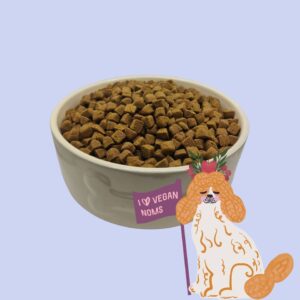
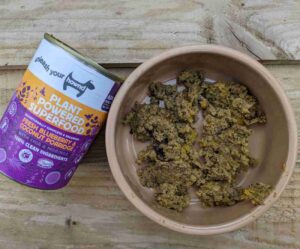
Commercially prepared vegan dog food has a very similar look and feel to traditional dog food and is available in the same forms i.e. wet and dry food, although vegan dog food smells a whole lot better than meat and fish products, believe me! Your dog’s poos might well smell better on a vegan diet too which is a little added bonus…
And most vegan dog foods, although not all, are nutritionally complete. That means they contain exactly the right nutrients that your dog requires to lead a healthy lifestyle, without you needing to add further supplements. So if the brand states that it is nutritionally complete, then it should be fine.
However, if a brand does not state clearly that it is nutritionally complete, you might be safer to assume that it is missing some vital ingredients. For example, there are some vegan dog foods which have been added to existing meat-based ranges that are not meant to be a complete replacement for your dog’s meat/fish diet, but are intended for occasional use only – a meat-free Monday kind of thing.
It wouldn’t be practical to list all the required nutrients and ingredients here, but if you follow the guidance above you should be able to rely on the product. All reputable dog food companies will also follow FEDIAF guidelines regarding the nutritional content requirements for their products, and are likely to reference this somewhere on their respective website. You can read more about the European pet food industry guidelines on the FEDIAF website here.
If you’d like a bit more help on the available vegan dog food brands, I have written a series of reviews, announcements and guides, and all the products listed are nutritionally complete, reliable and of very high quality:
Links to Vegan Mum’s other articles about vegan dog food brands:
- Best vegan dog food brands here
- Omni vegan dog food review
- Review of Noochy Poochy vegan dry dog food
- The Pack vegan dry dog food announcement
- Noochy Poochy collaboration announcement
I generally use commercially prepared vegan dog foods for my dog companion, Coco. I have tried her on quite a few different brands and after much trial and error, she has settled on a combination of the following:
- Omni’s Senior range dry food available here from Omni’s online store, and get an exclusive 50% discount using code veganmum50 at checkout (30% on one-off purchases).
- Green Crunch nutritionally complete dry food – you can buy Green Crunch from Amazon
- Hownd’s Blueberry and Coconut ‘Porridge’ wet food (to be honest, if my porridge looked like that I probably wouldn’t eat it, but Coco likes it…) – you can buy Hownd from Amazon
Home cooked food for dogs
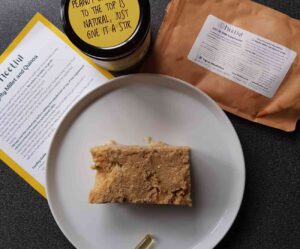
Some people prefer to cook food for their vegan dogs themselves. I do it for Coco from time to time and enjoy cooking for her. It’s a really great way of feeding your dog although I don’t have the freezer space to do it for her all the time. It is particularly useful if your dog has sensitivities of any kind too, because you will know exactly what is going into your their food.
However, there are some critically important things to remember if you do cook food for your dog:
- your dog’s nutritional requirements are complex
- supplementation will be required
- there are some things that your dog simply should not eat
I’d recommend using a recipe kit if you do decide to give homecooking a try because it takes the guesswork out of it. I use Fleetful and they provide all the basic non-perishable ingredients, the recipe cards, and the correct supplements to add to it. They really do make it very easy to cook healthy vegan food for your dog at home. The photo above is of a serving of Fleetful’s food I’ve made previously. Coco really likes it and it honestly looks good enough to eat yourself!
Want to find out more about home-cooked food for dogs?
- I’ve written more about cooking food for dogs here.
- You can also visit the Fleetful online shop here. If you do, you can use code veganmum10 for a 10% discount too!
Treats
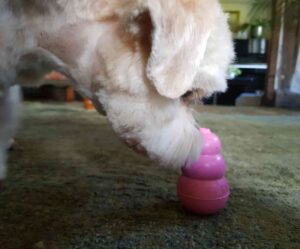
Vegan dog treats can take many different forms and you can either make them yourself, or buy one of the many quality vegan dog treats ‘off the shelf’. These should all be as the name suggest though, treats. A general rule of thumb is that treats should make up no more than 10% of your dog’s daily calorie intake, although most brands will offer specific advice about quantities.
I tend to look out for low fat vegan dog treats for Coco. I also try to avoid sweeteners like sorbitol because of Coco’s incredibly sensitive digestive system. This may not be a problem for many dogs, but do give it some thought and do some research, and take your vet’s advice if you have any concerns over your dog’s gastric health.
I have provided some suggestions and links below for vegan dog treats. Coco particularly loves these:
- a dried goji berry or two
- Omni vegan dog treats – you can buy direct from Omni here using code veganmum50 to get an exclusive 50% discount (30% on one-off purchases)
- Soopa’s banana and peanut butter dental sticks available on Amazon
- Hownd’s lovely new range of treats available on Amazon
- Lily’s Kitchen Woofbars – the cheapest way that I’ve found to buy these is multibuys on Lily’s Kitchen Amazon shop here
- Fleetful’s homemade dog treat kits (they’re wonderful) – you can buy direct from Fleetful here using code veganmum10 for an exclusive 10% discount
You can read Vegan Mum’s Omni vegan dog treats review for more details about this particular brand. Coco’s absolute bedtime favourite is Omni’s Peaceful Dogs treats. She has 2 of these little biscuits last thing at night and I’m always in trouble if we run out!
Fresh vegetables

Dogs have gut biomes too and they will benefit hugely from the nutrients contained in appropriately prepared fruits and vegetables in the right amounts, regardless of their diet. And if you stick to the most obvious vegetables like broccoli, green beans and carrots, you won’t go far wrong.
Coco, seen here tucking into some lightly steamed broccoli, loves vegetables, but before we embarked on her journey to becoming plant based, I just never thought to give her any! So she’d been missing out all those years! If your dog has been missing out too, then you can easily start introducing them into their diet.
I cut them into appropriately sized sticks, then steep them in a mug of boiling water for a few minutes to just soften them up a bit and make them more digestible. Coco is a small dog, and has one small stick of a vegetable each day.
Don’t forget though that you must introduce new foods slowly, and fruits and vegetables in particular could be introducing a whole load more fibre into your dog’s diet than they’re used to. Start small, and even once they’re used to them, they still don’t need them in huge quantities.
It’s also important to remember that not all fruits and vegetables are appropriate, and indeed, some foods are toxic for your dog. That includes foods like grapes and chocolate.
For more information on what you can and can’t feed your dog, see the following links:
- you can read some great medically reviewed advice about feeding your dog fruits and vegetables in this article by Forbes – what vegetables can dogs eat?
- the renowned Battersea Dogs & Cats Home has a great list here of the most toxic food for your dogs
- you can get more advice here from the UK Kennel Club’s list of poisonous food for dogs
Other vegan dog products

But it’s not just about the food. As a vegan, I won’t use leather or wool products for Coco either, and when it comes to her bath time, I don’t think she fully appreciates that her dog shampoo is vegan too! Actually, she just doesn’t appreciate bath time to be honest…
In addition to bath time, you may also want to consider buying non-wool dog coats and synthetic leads, harnesses and collars. You might find the links below helpful in your search for vegan dog products:
- have a read of my Best Vegan Dog Shampoo blog for more information on cleaning up your pooch after an appointment with some mud, or worse…
- visit BullyBillows online store if you’d like to find leads, collars and harnesses. They have a great range of non-leather products for dogs of all shapes and sizes
- Poseca dog coats on Amazon have a great range of non-wool fleeces and waterproofs
How do I make my dog a vegan?
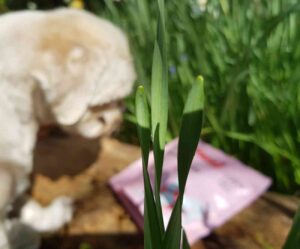
If you have decided to start your dog on the path towards a vegan diet, there are a few things you need to think about, including the following:
Does your dog have medical conditions?
If your dog has any known medical conditions then your first port of call should be your vet. Talk to them about transitioning your dog to a plant based diet and listen to any advice they may have. Bear in mind though that some vets may be unaware of the benefits of a plant based diet and say that a dog shouldn’t go completely vegan. It is still your decision, but it really helps to get your vet on side in these situations. Therefore, read some of the research I have cited, and also look at some of the recommended vegan dog foods and have that information ready to talk to your vet about.
My experience was very positive, however. My vet was totally supportive and seemed quite unconcerned by the food being vegan. Their concern for Coco was ensuring the food was low enough in fat because of her previous pancreatitis. I had already looked at the different products available and had chosen an appropriate wet and dry food – Omni Senior is below 8% fat and Hownd Blueberry and Coconut Porridge has been recently reformulated and is now at 2% fat (**8% fat dry weight).
**For advice on how to calculate the true fat content of a dog food, see the section below – How to calculate true fat content of dog food.
In addition to your vet, further help is available:
- if you take out a subscription with some of the vegan dog food companies, you can get free monthly online vet consultations. Both Omni and The Pack offer this amazing service
- You can book a teleconsultation with the wonderful vegan vet, Dr Arielle Griffiths (who runs vegan-dogfood.co.uk), who knows so much about nutrition for dogs
- Get in touch with Fleetful Dog Food who also offer great advice
How to calculate true fat content of dog food
A dog food may state it is low in fat, and quote a fat content e.g. 10% fat. That does sound low and for dogs without any medical or weight issues, that’s great. But the 10% quoted is likely to be as a fraction of the entire food, and that food (certainly if it’s wet food) will be made up of a combination of moisture and dry weight. For dogs like Coco, with a history of pancreatitis, she needs very low fat food. Consequently, I need to calculate the fat content as a % of the dry weight only to get a true picture of the fat level.
So, where fat (or any other constituent) is of critical medical importance to your dog, you should be aware of the calculation required to establish the level of that element as a % of dry weight only.
With all wet dog foods, and some dry, it should advise the ‘analytical constituents’ (sometimes found with the nutritional contents) including the moisture % of the food – it is this moisture level that should be ignored when making your calculations. I have given you an example below but if you are in any doubt, you should contact your vet or the pet food manufacturer.
Go to the ‘analytical constituents’ of the food you are interested in and find the moisture level – remember this is likely to be negligible or even zero in a dry dog food, but much higher in a wet food. Then, calculate the dry weight first by subtracting the stated moisture level from 100:
e.g. if the moisture level is 20%, the calculation is 100 – 20 = 80, so the dry weight of the food is 80
Next, take the stated fat content, and calculate it as a % of dry weight:
e.g. if the fat level is 10%, the calculation is 10 ÷ 80 = 0.125, then multiply that answer by 100 which = 12.5
This means the fat content as a % of dry weight is 12.5% – higher than the 10% quoted.
As I mentioned, this should not be an issue for a healthy dog – all dogs need fat – but that extra 2.5 % fat might make a huge difference to a dog like Coco.
What are your dog’s food preferences?
Think about your dogs food preferences – do they like wet food, dry kibble, a combination of the two, or even homemade. All of these preferences can easily be met on a vegan diet and you’ll be more likely to transition your dog to a vegan diet smoothly and successfully if you stick to familiar textures. Commercially prepared vegan dog foods are remarkably similar in presentation and form to traditional meat and fish-based dog foods, and homecooking is, well…homecooking!
Choose your vegan dog food
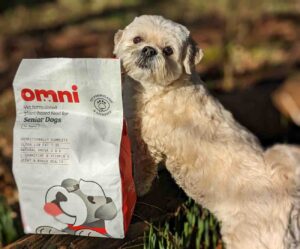
With your dog’s preferences and medical conditions in mind, you then have quite an array of vegan dog food options to choose from, whether that’s deciding to cook for your dog yourself, or to buy a commercially prepared brand. As I suggested in the Main Meals section of this article, you should consider the following:
If looking at a brand of ready made food:
- is it nutritionally complete?
- does it follow FEDIAF guidelines?
If thinking about cooking for your dog, do you have:
- nutritious recipes
- appropriate supplementation
Helpful articles here on Vegan Mum to help you choose the right food for your pooch include:
- Best vegan dog food brands
- Omni vegan dog food review
- Review of Noochy Poochy vegan dry dog food
- Cooking food for dogs
Plan the transition to their new vegan diet

If you do decide to change your dog’s diet, and whatever you change it to, don’t forget one critically important point: you must change your dog’s diet slowly. Their digestive systems are far more sensitive than you might think, and making sudden changes to a dog’s diet can make them very uncomfortable and have a quite devastating effect on their tummies. Do this even when changing from one brand to another where the ingredients look the same.
There is all sorts of advice online about how to transition your dog to different food, and not all of it is appropriate, as Coco found out – you can see she carried out some research on her laptop!
Seriously though, there is a general rule that many brands suggest:

| Day | New Food | Old Food |
| 1 – 4 | 25% | 75% |
| 5 – 8 | 50% | 50% |
| 9 – 12 | 75% | 25% |
| 13 onwards | 100% | – |
To be honest though, I have done it even more slowly than that simply by not ploughing in with 25% of new food straight away. With Coco, I made a more gentle introduction of 10% new food for 3 days, then moving to the plan above.
Helpful Links:
The PDSA has some very clear guidelines on changing your dog’s food and it concurs with advice given by the British Veterinary Association and various kennel clubs too. The brand you are switching too should also offer similar advice, so do look at the packaging of the new food for more information.
Coco’s journey to becoming a vegan dog
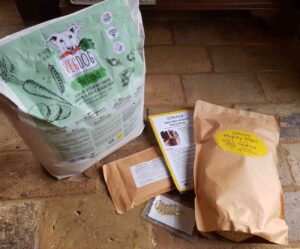
Coco is a 10 year old Lhasa Apso, with a nasty episode of pancreatitis in her medical history when she was nearly 8. Her illness was awful, her survival was touch and go, and I have done everything I can ever since to ensure she doesn’t go through that again.
Prior to her pancreatitis, she ate wet food from Lily’s Kitchen, a well-known, high quality brand of meat and fish-based dog food. She often seemed to experience abdominal discomfort after eating – hunching and trembling – but we never seemed able to diagnose the problem, even with vet advice.
Then, one night she became very ill, the symptoms were far more obvious, and she was diagnosed with pancreatitis.
After her illness, she was no longer able to eat Lily’s Kitchen because, like most standard dog foods, the fat content was too high for a dog with a history of pancreatitis. So I followed my vet’s advice and Coco went on to a prescription diet – Royal Canin’s low fat gastrointestinal dog food. This is a very, very low fat, meat-based prescription food and is a life-saver for so many dogs, so I am not going to underestimate its value here. Coco was never a huge fan of kibble, so whilst I gave her a small percentage of the dry food, the majority of her diet was the Royal Canin tinned wet food.
But, Coco’s hunching and trembling after eating remained and continued for many months, so something that we had in hindsight put down to early signs of her pancreatitis looked like it was actually being caused by something else. I considered food sensitivities and consequently searched for a low fat non-prescription diet.
I looked at every vegan wet dog food I could find, but not one of them was low enough in fat, so I eventually decided on Burns Fish and Rice wet food. From an elimination perspective, I would at least be able to tell if meat was her problem. I spoke to their very helpful nutritionists and they confirmed that this particular product, with it’s relatively low fat content, should be fine for dogs with pancreatitis. Again, like Lily’s Kitchen, this is a high quality food, but after slowly transitioning her onto it, there was no improvement in her discomfort after eating.
To cut a very long story short, and after many (expensive!) vet visits, we were persuaded to put her back onto the Royal Canin, which she continued to eat for many months. However, she started being sick again more frequently, was quite lethargic, and her shaking and occasional groans after eating became even more distressing for her and for us because we just didn’t know how to help her.
Then, in came the cavalry in the form of Dr Arielle Griffiths, a vegan vet! After a very useful consultation with her, I decided that plant based really was the way to go to help Coco, but because no commercially prepared vegan wet food was low enough in fat, I started cooking for Coco using Fleetful’s recipe kits. The kits made it so easy to do. In addition, Dr Griffiths recommended a dry dog food, Green Crunch, to augment the homecooked food.
I also decided to complete Dr Arielle’s online vegan dog nutrition course which was enormously helpful, gave me so much reassurance about what I was doing, and also confidence in what I could feed Coco. See the section on where to get help below if you’d like to know more about this course. Whilst the course isn’t cheap, it was worth every penny to me.
Unfortunately, freezer space became a bit of an issue for me, but then I found that Hownd had reformulated one of their tinned wet vegan dog foods – the coconut and blueberry porridge – so it was now suitable for Coco to eat. I gradually moved her across to the tins of Hownd mixed with Green Crunch, but also wanted her to keep some of the variety that she was getting when I cooked for her (which I still do from time to time).
Then Omni, a vegan dog food company, approached me to do an online review for them. Their Senior range of dry food was a low fat formulation, but I mentioned that dry food isn’t Coco’s favourite. Easy, they said, just dampen it with water. Now why didn’t I think of that?
Coco loved it and because Green Crunch is a little higher in fat than I would like for Coco, she now has a regular combination of Hownd wet food, Green Crunch and Omni Senior, with the odd homecooked offering. (she loves quinoa, tofu and vegetables and even gets away with the odd smidgen of peanut butter – enough to cover a pinhead only because of the fat content but for her, the smell is enough!
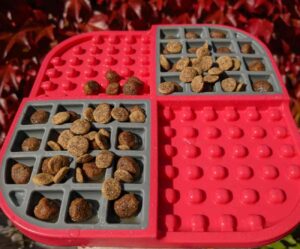
And what a happy dog she is. The wholesale vomiting has gone completely (apart from the odd grass eating session which I think is quite normal), and although she does still have the odd tremble after eating, it often disappears after a bit of a burp! (Yes, I do now help ‘wind her’ just like I used to with my children when they were babies…)
A further bonus is that she doesn’t seem to itch anything like as much either, no longer scratching and violently rubbing her head against my rug and sofa – her regular go-tos for serious scratching opportunities! Dr Arielle Griffiths mentioned that itching is often caused by food sensitivities and all but disappears when dogs move to a vegan diet.
Coco loves her food, enjoys the variety I can now offer her, eats more dry food because I spray it with lots of water (is that technically wet food then?!) and is full of energy. She doesn’t walk quite as far as she used to – she’s 10 now and only has little legs really – but still manages a good distance, and duck, her favourite toy, still gets a regular outing.

Where can I get help to make my dog vegan?
You’re making an important decision on behalf of your dog, so do your research and consider seeking advice from people who have knowledge in this area if you’re unsure about anything. Helpful contacts and advice include:
- book a teleconsultation with Dr Arielle Griffiths (who runs vegan-dogfood.co.uk). This is an invaluable 1-2-1 personal consultation with someone who knows so much about nutrition for dogs
- read about Dr Arielle’s dog nutrition course here, or book directly onto the course here and gain immediate online access to it
- Get in touch with Fleetful Dog Food who also offer great advice
- if you take out a subscription with some of the vegan dog food companies, you can get free monthly online vet consultations. Both Omni and The Pack offer this amazing service
- your vet
Here at Vegan Mum, I have also conducted a lot of research, moved my dog companion over to a vegan diet, and have written several useful guides and reviews that you may find useful:
- Best vegan dog food brands
- Omni vegan dog food review
- Review of Noochy Poochy vegan dry dog food
- Cooking food for dogs
- Omni vegan dog treats review
- The Pack dry food new product announcement
- Noochy Poochy collaboration announcement
- Best Vegan Dog Shampoo blog
Conclusion of the tale of Coco, a vegan dog

Coco has now been on a totally vegan diet for well over 6 months now, and is thriving. Her coat is in great condition, she is full of energy, enjoys her walks and is cheeky, playful and stubborn. She was all these things before she became a vegan dog, but there are new benefits that I can only think are due to her plant based diet. She is rarely sick, shaking with pain after eating has all but disappeared, and her frantic scratching is just a memory, so I’m confident that I have made the right decision for her as she now moves into her senior years.
Would Coco still eat meat if it was presented to her? Of course she would! Dogs are omnivores and given that she’ll chase squirrels, rabbits and pheasants means that she probably doesn’t share my ethical vegan values, so meat would be just fine in her eyes. Not that I worry about her catching anything; I’ve actually seen rabbits stop and file their nails whilst watching Coco come thundering towards them at a rate of, well…at a snail’s pace…and then just hop down the nearest hole. Lhasa Apsos are sturdy little things, but they’re not built for speed!
But she doesn’t need meat, and that’s the point. With a nutritionally complete vegan diet, a dog will get all the nutrients they need to live a full and healthy – and I think healthier – life.
So, if you’ve managed to read this far, well done! I hope our experience, and the resources I have mentioned, will be of some help to you if you’re thinking about a vegan diet for your dog. I’m certainly glad I’ve done it, and I think if she could speak, Coco would say that she is too!



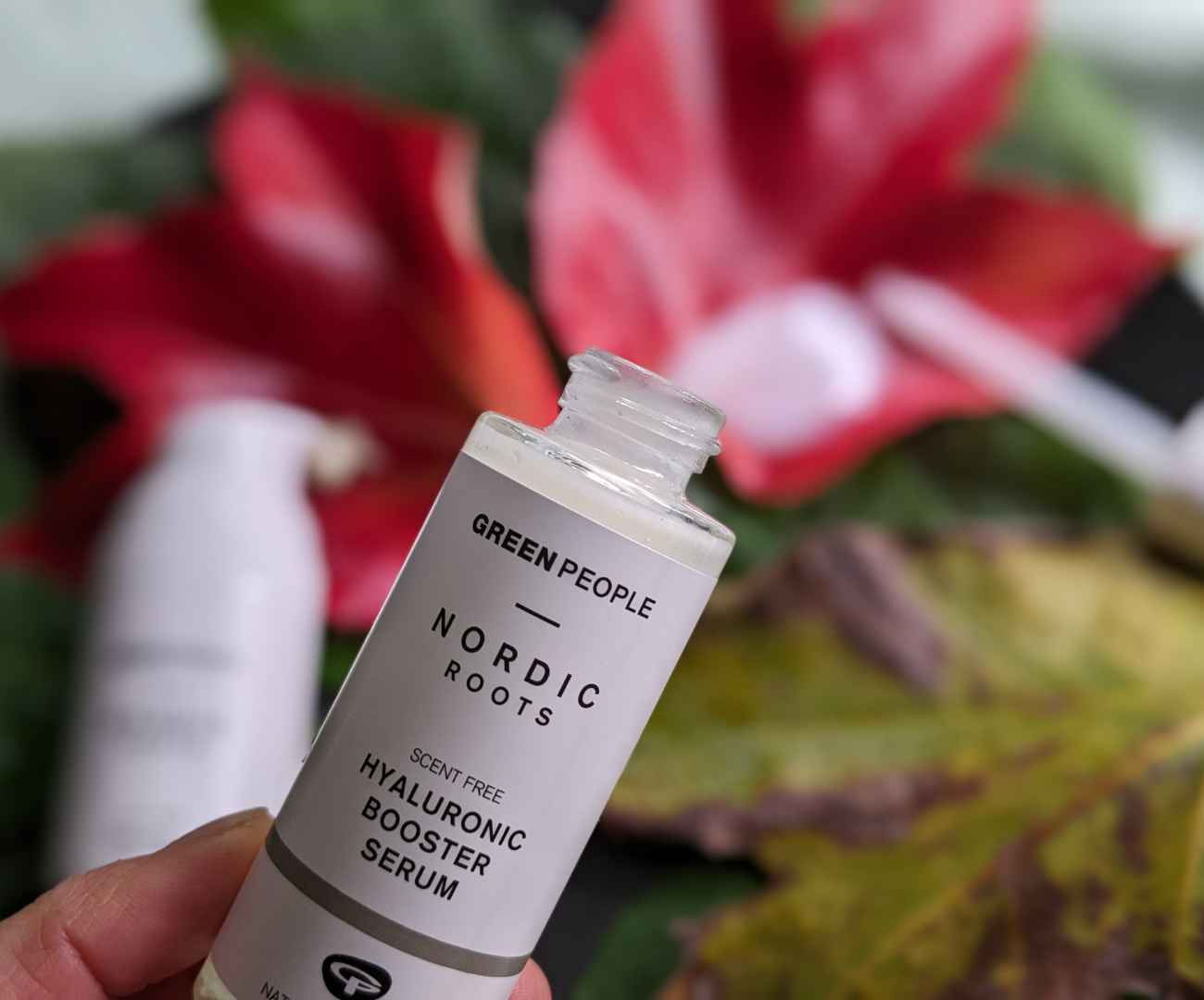
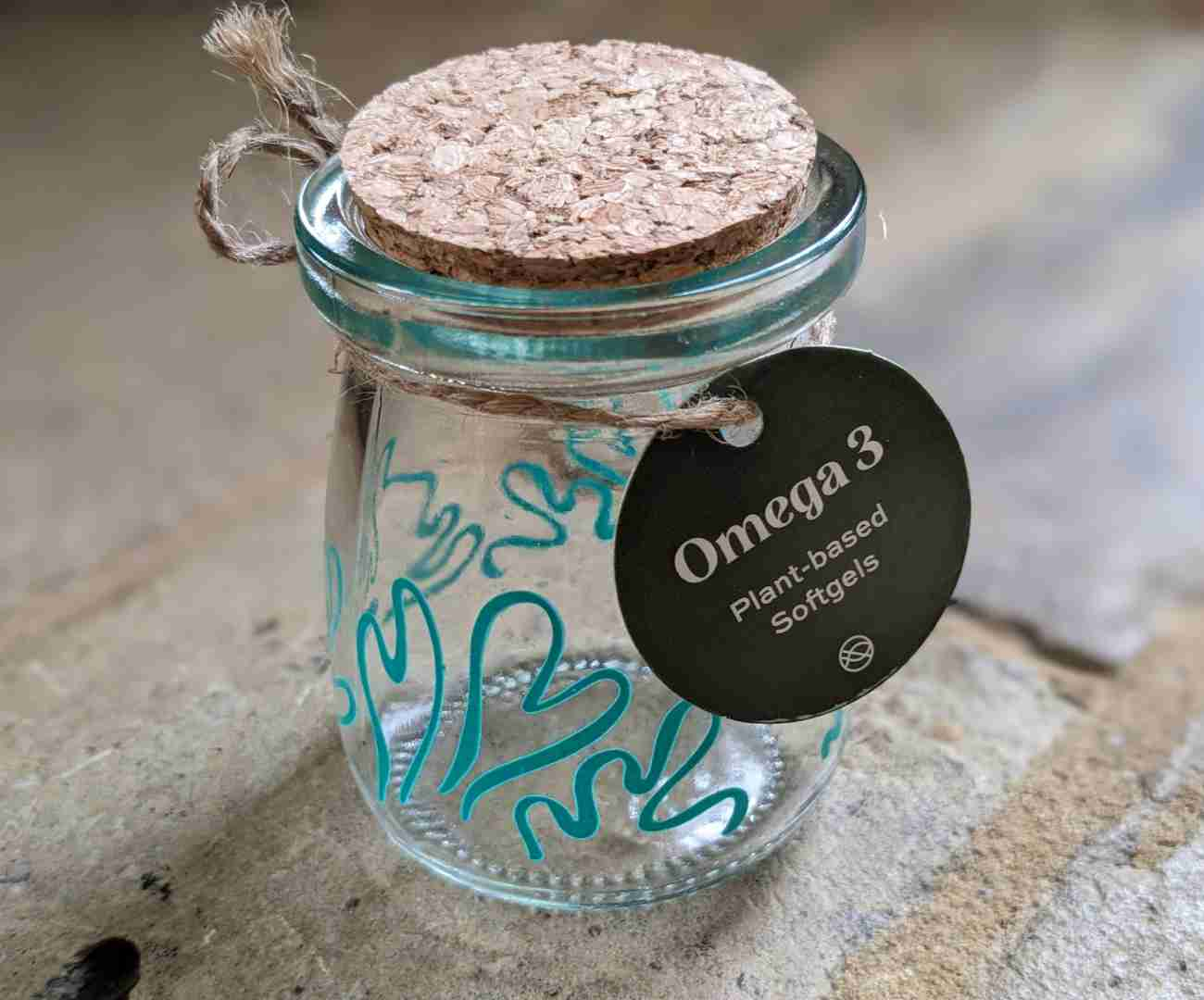

Leave a Reply